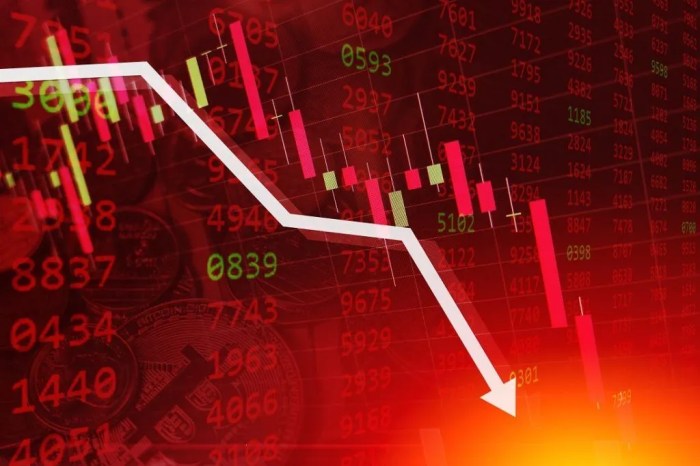As Stock market crashes takes center stage, this opening passage beckons readers with american high school hip style into a world crafted with good knowledge, ensuring a reading experience that is both absorbing and distinctly original.
Buckle up as we delve into the causes, impacts, strategies, and historical context of Stock Market Crashes. Get ready to ride the waves of financial turmoil and triumph!
Causes of Stock Market Crashes

When it comes to stock market crashes, there are several economic factors that can play a role in triggering these significant downturns. Investor sentiment, external shocks, and economic indicators all contribute to the volatility of the market.
Economic Factors Contributing to Stock Market Crashes
- Overvaluation of Stocks: When stock prices are inflated beyond their true value, a correction can lead to a crash.
- Economic Downturns: Recessions or economic contractions can cause investors to panic and sell their stocks, leading to a crash.
- Interest Rate Changes: Sudden shifts in interest rates can impact borrowing costs for businesses and consumers, affecting overall market stability.
Historical Events Leading to Significant Market Downturns
- Black Tuesday (1929): The stock market crash of 1929, known as Black Tuesday, was caused by a combination of overvalued stocks, excessive speculation, and panic selling.
- Dot-Com Bubble Burst (2000): The burst of the dot-com bubble in 2000 was triggered by the collapse of many internet-based companies that were overvalued.
Role of Investor Sentiment in Triggering Crashes
- Fear and Greed: Investor emotions like fear and greed can drive market movements, leading to irrational behavior and contributing to market crashes.
- Herd Mentality: When investors follow the crowd without considering fundamental factors, it can create market bubbles that eventually burst.
Impact of Stock Market Crashes
When a stock market crash occurs, it can have far-reaching effects on both the economy and individual investors. The repercussions can be significant and long-lasting, impacting various aspects of the financial landscape.
Economic Impact
- Stock market crashes can lead to a decrease in consumer spending and business investments, as people become more cautious about their financial stability.
- Companies may find it harder to raise capital through the stock market, affecting their ability to fund operations and expansion.
- Unemployment rates may rise as businesses struggle and cut costs to weather the financial storm.
- Overall economic growth can slow down or even decline, leading to a recession if the crash is severe enough.
Impact on Individual Investors
- Individual investors can see a significant decrease in the value of their portfolios, resulting in substantial financial losses.
- Retirement savings and investments can take a hit, affecting long-term financial planning and goals.
- Investor confidence may wane, leading to panic selling and further exacerbating the market downturn.
Market Crashes and Financial Crises
- Stock market crashes can trigger financial crises when they spread to other sectors of the economy, such as housing or banking.
- Financial institutions may face liquidity issues and solvency concerns, threatening the stability of the entire financial system.
- Governments and central banks may need to intervene with stimulus measures to prevent a full-blown financial meltdown.
Strategies to Mitigate Risks during Stock Market Crashes
In times of stock market crashes, it is essential for investors to have strategies in place to mitigate risks and protect their investments. By employing risk management techniques, diversification, and hedging strategies, investors can navigate turbulent times more effectively.
Risk Management Techniques
Risk management techniques involve assessing and managing the risks associated with investments. Investors can use tools like stop-loss orders to limit potential losses by automatically selling a security when it reaches a certain price. Additionally, setting clear investment goals and maintaining a diversified portfolio can help mitigate risks during market downturns.
Diversification and its Importance
Diversification is a key strategy to reduce risk during stock market crashes. By spreading investments across different asset classes, industries, and geographic regions, investors can minimize the impact of a downturn in any single investment. This helps to protect the overall portfolio from significant losses.
Hedging Strategies
Hedging involves taking positions that offset potential losses in an investment. For example, investors can use options contracts to protect their portfolio from downside risk. Put options give the holder the right to sell a security at a specified price, providing a form of insurance against market declines. By incorporating hedging strategies, investors can safeguard their investments during market crashes.
Historical Stock Market Crashes
The history of the stock market is filled with instances of sudden and severe crashes that have had lasting impacts on the global economy. Understanding these events and their causes can provide valuable insights into the functioning of financial markets.
The Great Depression Crash
The Great Depression crash of 1929 remains one of the most famous and devastating stock market crashes in history. The crash was triggered by a combination of factors, including overvalued stocks, excessive speculation, and a lack of government regulation. The collapse of the stock market led to a severe economic downturn, with widespread unemployment and bankruptcies.
Comparing to Recent Market Downturns
In more recent times, we have witnessed market downturns like the Dot-Com Bubble burst in 2000 and the Global Financial Crisis in 2008. While these crashes were caused by different factors compared to the Great Depression, they still had significant impacts on the economy and financial markets. The Dot-Com Bubble burst was driven by overvaluation of tech stocks, while the Global Financial Crisis was fueled by subprime mortgage lending practices.
Lasting Effects on the Financial Industry
Major stock market crashes have often led to increased government regulation and oversight of financial markets. The Great Depression, for example, led to the establishment of the Securities and Exchange Commission (SEC) to protect investors and maintain fair and efficient markets. Similarly, the Global Financial Crisis resulted in the implementation of stricter banking regulations to prevent future financial meltdowns.
